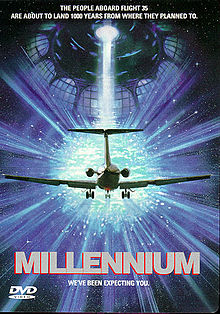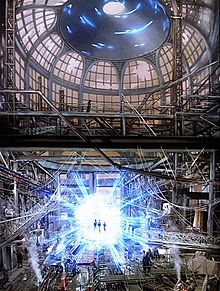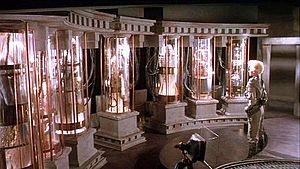- Millennium (film)
-
Millennium 
Theatrical posterDirected by Michael Anderson Produced by John M. Eckert
Freddie Fields
John C. Foreman
Louis M. SilversteinWritten by John Varley Starring Kris Kristofferson
Cheryl Ladd
Robert Joy
Brent Carver
Al Waxman
Daniel J. TravantiMusic by Eric N. Robertson Cinematography Rene Ohashi Editing by Ron Wisman Studio Gladden Entertainment Distributed by 20th Century Fox (theatrical)
Artisan Entertainment (DVD)Release date(s) August 25, 1989 Running time 108 min. Country  United States
United StatesLanguage English Box office US$5,777,000 Millennium is a 1989 film directed by Michael Anderson and starring Kris Kristofferson, Cheryl Ladd, Robert Joy, Brent Carver, Al Waxman and Daniel J. Travanti. The original music score was composed by Eric N. Robertson. The film was marketed with the tagline "The people aboard Flight 35 are about to land 1,000 years from where they planned to."
Millennium is based on the 1977 short story "Air Raid" by John Varley. Varley started work on a screenplay based on that short story in 1979, and later released the expanded story in book-length form in 1983, titled Millennium. After four different directors, a film was finally released in 1989.
Contents
Plot
The film begins in the cockpit of a U.S. passenger airliner (Boeing 747), shortly before they are struck from above by another airliner (McDonnell Douglas DC-10) on a landing approach. The pilot handles the airplane as well as he can while the flight engineer goes back to check on the passenger cabin. He comes back in the cockpit screaming, "They're all dead and burned!"
Bill Smith (Kristofferson) is a National Transportation Safety Board investigator hired to determine whether human error is the cause of a collision of two jumbo jets, both of which crashed. He and his team of investigators are confused by the words on the cockpit voice recorder because there had been no fire on board before the plane hit the ground. At the same time, a theoretical physicist named Dr. Arnold Mayer (Travanti) has a professional curiosity about the crash, which borders on science fiction. While giving a lecture, he talks about time travel and the possibility of visitors from the future.
Time travelers are, in fact, visiting the present day and stealing passengers from doomed aircraft. Every incursion into the past causes an accompanying "timequake" whose magnitude is proportional to the effects of the incursion into the past. Each "timequake" causes physical damage in the time from which the incursion has been made. This is why they are abducting people who will not be able to impact the future any further and replacing them with copies of those who would have died. Thus, the co-pilot's strange comment came because all the passengers had been replaced with pre-burned duplicates in preparation for the upcoming crash.
While on one of the missions, an operative is shot and loses a stun weapon on board a plane before it crashes. This weapon winds up in the possession of Dr. Arnold Mayer, setting him on the path to working out what's happening. Twenty-five years later, Smith finds a similar artifact in the crash portrayed at the beginning of the film.
Worried that these two individuals of the 20th century might change history by their discoveries, Louise Baltimore (Ladd) travels back to 1989 in order to distract Bill Smith and discourage him from pursuing his investigation further. Louise manages to gain Bill's trust, as well as seduce him into a one-night stand, which she hopes will complete the distraction. However, because of still more errors on the part of the time travel team, as well as paradoxical events, Bill becomes even more suspicious. He soon pays a visit to Dr. Mayer. At that point, Louise materializes from the future and reveals her mission to both of them. In a mishap with the stun weapon, Mayer kills himself thereby causing a major change to the timeline. Louise decides to take Bill with her to the future.
Between Louise's recent visit and exposition in the future, we find that because of pollution, the human population of the future is no longer able to reproduce, except for Louise who's pregnant with Bill's baby, though that fact isn't revealed until the very end of the film. This is why they have been abducting people from the past and keeping them in stasis until a future time when they will be sent into the far future. It is hoped that in this far future, the Earth will have recovered enough that humans can repopulate the planet. The recent incursion results in a force infinity timequake which will destroy the entire civilization of the "present" future and the Gate (time machine) itself. It is decided that it is time to send all of the people who have been collected to the distant future before the Gate is destroyed.
Bill and Louise step through and disappear into the Gate, which takes them to another time and another place, in order to save their lives, and to fulfill a destiny to repopulate Earth. A simple, but poignant, message is recited by Sherman the Robot, quoting Winston Churchill, in the closing seconds of the film. As the blast wave of the gate being destroyed vaporizes Sherman he states, "This is not the end. This is not the beginning of the end. It is the end of the beginning" as the scene transitions to the sun rising above the clouds. The message implies the philosophical underpinnings of the story in that life is cyclical and starts anew with the death of the old, the true balance of universal existence.
Cast
- Kris Kristofferson: Bill Smith
- Cheryl Ladd: Louise Baltimore
- Daniel J. Travanti: Dr. Arnold Mayer
- Robert Joy: Sherman the Robot
- Lloyd Bochner: Walters
- Brent Carver: Coventry
- David McIlwraith: Tom Stanley
- Maury Chaykin: Roger Keane
- Al Waxman: Dr. Brindle
- Lawrence Dane: Captain Vern Rockwell
- Thomas Hauff: First Officer Ron Kennedy
- Peter Dvorsky: Don Janz
- Raymond O'Neill: Harold Davis
- Philip Akin: Kevin Briley
- Susannah Hoffman: Susan Melbourne
- Victoria Snow: Pinky Djakarta
- Claudette Roche (as Claudette Roach): Inez Manila
- Bob Bainborough: Investigator
- Cedric Smith: Eli Seibel
- Edward Roy: Gantry Controller
- Gary Reineke: Carpenter
- Michael J. Reynolds: Jerry Bannister
- Chapelle Jaffe: Council Chamber Member, Stockholm
- Christopher Britton: Council Chamber Member, Buffalo
- Gerry Quigley: Council Chamber Member, Khartoum
- Leonard Chow: Council Chamber Member, Beijing
- Jamie Shannon: Young Bill Smith
- Yank Azman: Evacuation Leader
Production
After four different directors, a film was finally released in 1989.
“ We had the first meeting on Millennium in 1979. I ended up writing it six times. There were four different directors, and each time a new director came in I went over the whole thing with him and rewrote it. Each new director had his own ideas, and sometimes you'd gain something from that, but each time something's always lost in the process, so that by the time it went in front of the cameras, a lot of the vision was lost.[1] ” Millennium's production designer, Gene Rudolf, had to produce a future setting that implied putrefaction and atrophy.
The largest set was the time-travel center for Louise Baltimore's operation. Rudolf created rusted catwalks that traversed a large open space. Buildings crumbled and exposed their infrastructures. The walls were painted dull green, black and coppery. Rudolf wanted the future to look dirty, sick and poisoned.
Several scenes are set in the vault for the decrepit council members overseeing the time travel operation. Rudolf designed their chamber as a semicircle of seven transparent, upright cylinders, each serving as a life-support device. Four of the cylinders held actors. The others were filled with bodily organ props and medical equipment that served as the last still living remnants of these members.
To create the time-travel effects of the Gate itself, cinematographer René Ohashi produced the ghostly shimmering lights by spinning metal wheels covered in Mylar.
Since actual aircraft could not be sent through the set, miniature models and a full-size mock-up of the tail-section of a Boeing 707 were used. Optical effects were used to make the planes look as if they were entering the set.
The penultimate scene took place in a contemporary American home. Rudolf's set was dominated by large horizontal windows. The room was filled with clocks, hourglasses and navigational equipment, in line with Dr. Arnold Mayer's fascination with time travel. Emmett "Doc" Brown in Back to the Future and George, the time traveler in The Time Machine both had similar homes filled with clocks due to their fixations on time travel.
The scenes shot in the airport terminal buildings were actually shot at Toronto Lester B. Pearson International Airport, in the former Terminals 1 & 2. For the outdoor shot where Baltimore (Ladd) steals the car, two-way traffic was run in front of the Terminal 2 arrivals level where it is ordinarily a one-way road.
Re-releases
On the VHS of the film is simply an ending showing the sun rising over clouds. The DVD version, released around 1999, swaps the VHS ending in favor of one showing the two main characters from underneath floating in water. From there, it switches to a view from one side showing them embracing nude, with nothing especially visible. The DVD version has four special features including an alternate ending.
References
- ^ Interview in St. Louis Post-Dispatch Monday, July 20, 1992
External links
- Millennium at the Internet Movie Database
- Millennium at AllRovi
- Millennium at Rotten Tomatoes
- John Varley's official website
Michael Anderson 1950s Will Any Gentleman...? · The House of the Arrow · The Dam Busters · 1984 · Around the World in Eighty Days · Yangtse Incident · Chase a Crooked Shadow · Shake Hands with the Devil · The Wreck of the Mary Deare1960s 1970s 1980s The Jeweler's Shop · Millennium1990s Television The Martian Chronicles (1980) · Sword of Gideon (1986) · Young Catherine (1991) · 20,000 Leagues Under the Sea (1997)Categories:- 1989 films
- 1980s science fiction films
- American aviation films
- American independent films
- American science fiction films
- English-language films
- Films based on science fiction novels
- Films based on short fiction
- Films directed by Michael Anderson
- Time travel films
- 20th Century Fox films
Wikimedia Foundation. 2010.


